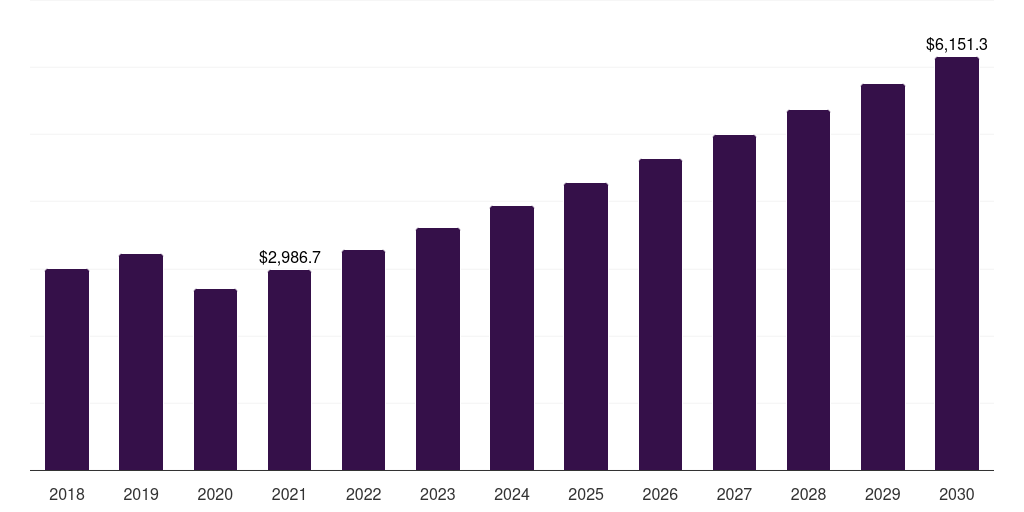Europe Anti-wrinkle Products Market Size & Outlook
Europe anti-wrinkle products market, 2018-2030 (US$M)
Related Markets
Europe anti-wrinkle products market highlights
- The Europe anti-wrinkle products market generated a revenue of USD 2,986.7 million in 2021.
- The market is expected to grow at a CAGR of 8.4% from 2022 to 2030.
- In terms of segment, vitamin c (absorbic acid) was the largest revenue generating active ingredients in 2021.
- Hydroxy Acids is the most lucrative active ingredients segment registering the fastest growth during the forecast period.
- Country-wise, UK is expected to register the highest CAGR from 2022 to 2030.
Europe data book summary
| Market revenue in 2021 | USD 2,986.7 million |
| Market revenue in 2030 | USD 6,151.3 million |
| Growth rate | 8.4% (CAGR from 2021 to 2030) |
| Largest segment | Vitamin c (absorbic acid) |
| Fastest growing segment | Hydroxy Acids |
| Historical data covered | 2018 - 2020 |
| Base year for estimation | 2021 |
| Forecast period covered | 2022 - 2030 |
| Quantitative units | Revenue in USD million |
| Market segmentation | Retinoids, Niacinamide, Vitamin C (Absorbic Acid), Hydroxy Acids, Glycolic Acid, Citric Acid, Lactic Acid, Coenzyme Q10, Peptides, Tea Extracts, Grape Seed Extracts |
| Key market players worldwide | L'Oreal SA, Procter & Gamble Co, Johnson & Johnson, Unilever PLC, Walgreens Boots Alliance Inc, La Roche-Posay, Galderma Group AG Registered Shares, The Estee Lauder Companies Inc Class A, Shiseido Co Ltd, Life Extension, Clarins Group |
Other key industry trends
- In terms of revenue, Europe region accounted for 30.2% of the global anti-wrinkle products market in 2021.
- Globally, Asia Pacific is projected to lead the regional market in terms of revenue in 2030.
- Asia Pacific is the fastest growing regional market and is projected to reach USD 8,367.5 million by 2030.
No credit card required*
Horizon in a snapshot
- 30K+ Global Market Reports
- 120K+ Country Reports
- 1.2M+ Market Statistics
- 200K+ Company Profiles
- Industry insights and more
Anti-wrinkle Products Market Scope
Anti-wrinkle Products Market Companies
| Name | Profile | # Employees | HQ | Website |
|---|
Europe anti-wrinkle products market outlook
The databook is designed to serve as a comprehensive guide to navigating this sector. The databook focuses on market statistics denoted in the form of revenue and y-o-y growth and CAGR across the globe and regions. A detailed competitive and opportunity analyses related to anti-wrinkle products market will help companies and investors design strategic landscapes.
Vitamin c (absorbic acid) was the largest segment with a revenue share of 17.98% in 2021. Horizon Databook has segmented the Europe anti-wrinkle products market based on retinoids, niacinamide, vitamin c (absorbic acid), hydroxy acids, glycolic acid, citric acid, lactic acid, coenzyme q10, peptides, tea extracts, grape seed extracts covering the revenue growth of each sub-segment from 2018 to 2030.
The demand for anti-wrinkle products in Europe is significant, as consumers are becoming increasingly concerned with the appearance of aging. The aging population is a major factor contributing to the growing demand for anti-wrinkle products.
Consumers in the region prefer high-quality; effective anti-wrinkle products that can help reduce the appearance of fine lines and wrinkles. In addition, the growing reluctance of non-invasive cosmetic procedures, such as dermal fillers and botox injections has further fueled the demand for anti-wrinkle products in Europe.
For instance, in 2019, as per the International Society of Aesthetic Plastic Surgery (ISAPS), close to 4,315,859 procedures involving dermal fillers were performed in the region. Many consumers are seeking less invasive and more affordable alternatives to these procedures, which has led to increased demand for topical anti-wrinkle products.
Reasons to subscribe to Europe anti-wrinkle products market databook:
-
Access to comprehensive data: Horizon Databook provides over 1 million market statistics and 20,000+ reports, offering extensive coverage across various industries and regions.
-
Informed decision making: Subscribers gain insights into market trends, customer preferences, and competitor strategies, empowering informed business decisions.
-
Cost-Effective solution: It's recognized as the world's most cost-effective market research database, offering high ROI through its vast repository of data and reports.
-
Customizable reports: Tailored reports and analytics allow companies to drill down into specific markets, demographics, or product segments, adapting to unique business needs.
-
Strategic advantage: By staying updated with the latest market intelligence, companies can stay ahead of competitors, anticipate industry shifts, and capitalize on emerging opportunities.
Target buyers of Europe anti-wrinkle products market databook
-
Our clientele includes a mix of anti-wrinkle products market companies, investment firms, advisory firms & academic institutions.
-
30% of our revenue is generated working with investment firms and helping them identify viable opportunity areas.
-
Approximately 65% of our revenue is generated working with competitive intelligence & market intelligence teams of market participants (manufacturers, service providers, etc.).
-
The rest of the revenue is generated working with academic and research not-for-profit institutes. We do our bit of pro-bono by working with these institutions at subsidized rates.
Horizon Databook provides a detailed overview of continent-level data and insights on the Europe anti-wrinkle products market , including forecasts for subscribers. This continent databook contains high-level insights into Europe anti-wrinkle products market from 2018 to 2030, including revenue numbers, major trends, and company profiles.
Partial client list
Europe anti wrinkle products market size, by country, 2018-2030 (US$M)
Europe Anti-wrinkle Products Market Outlook Share, 2021 & 2030 (US$M)
Related industry reports
Related regional statistics
Sign up - it's easy, and free!
Sign up and get instant basic access to databook, upgrade
when ready, or enjoy our
free plan indefinitely.
Included in Horizon account
- 30K+ Global Market Reports
- 120K+ Country Reports
- 1.2M+ Market Statistics
- 200K+ Company Profiles
- Industry insights and more




